Contents
Description
Olive oil is considered one of the healthiest foods for a reason. It is actively used in cooking, medicine and cosmetology. However, in addition to its benefits, the oil also has harmful properties.
Vegetable oil obtained from olives. Differs in color from light yellow to dark green, depending on the degree of ripeness of the fruit. It is a national product of Italy, Greece, Spain.
Olive oil history
The history of olive oil goes back many millennia. So, in the wild, olives have existed for 14 thousand years. In ancient Babylon, archaeologists have found a cuneiform tablet with a contract for the purchase of 25 liters of the highest quality olive oil by a certain lord Sin-Ashared.
According to legend, once a man could make his way from Mecca to Morocco in the shade of olive, fig and date trees. The homeland of olive trees was Southwest Asia. Travelers’ caravans, laden with the fruits of the olive tree, delivered them even to places where no one had ever tasted olives before. The kings and rulers of ancient states even estimated the size of their fortune in jugs of olive oil stored in the basements of the palace.
People began to purposefully breed them about 6 thousand years ago on the island of Crete. From there, presumably not without the involvement of the Phoenicians, tireless sailors, the olive culture spread throughout the Mediterranean coastline, and the world history of olive oil began.
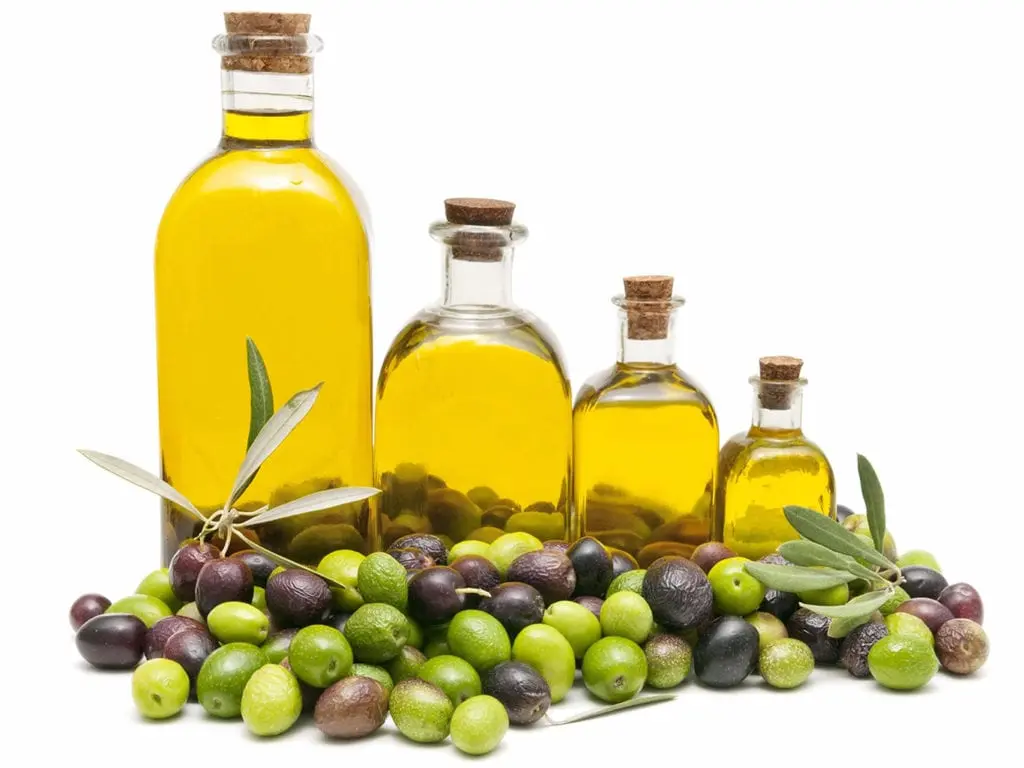
Once upon a time, even in the now bare and deserted regions of North Africa, olive trees grew.
The history of the spread of olives is the history of the conquest of weaker civilizations by stronger civilizations. The cunning Romans, for example, subjugated many lands, allowing local residents to grow such a lucrative crop as olives in return.
And amphorae in the Greek style are still found in the Mediterranean basin. There is hardly any other culture that deified the olive as much as the Greeks. She was considered a gift of the goddess Athena, a symbol of wisdom, strength and longevity, she was adorned with kings and wreaths of the winners of the Olympiads.
Even the inhabitants of Athens were compared to the branches and leaves of an olive tree, which cannot be destroyed by any enemy, since they immediately grow again.
Composition and calorie content
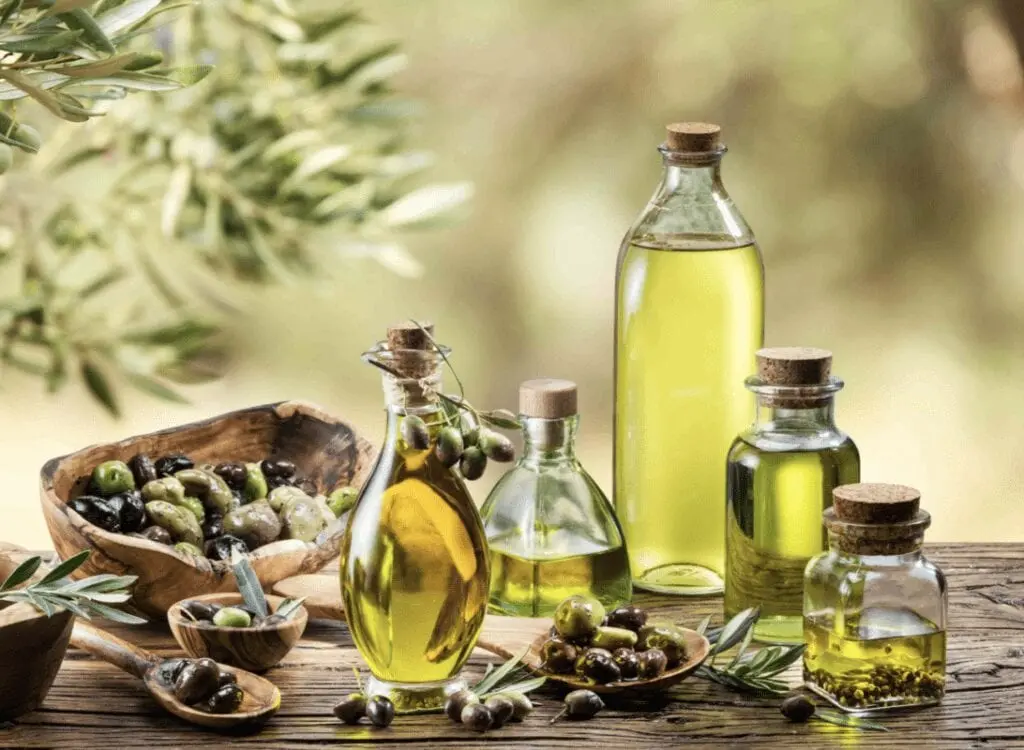
Olive oil is 55-83% composed of oleic acid, which is also called omega-9, 3.5-21% linoleic acid and 7.5-20% palmitic acid. In addition, it contains stearic acid, polyphenols, vitamins A, E, D, K.
100 grams of the product contains 900 kcal.
- Proteins 0 g
- Fat 99.8 g
- Carbohydrates 0 g
The benefits of olive oil
Olive oil is rich in oleic acid, which promotes optimal metabolic processes, strengthens the walls of blood vessels. Omega-9 fatty acids in its composition have an anticarcinogenic effect, help lower blood pressure, normalize blood cholesterol levels, and are useful for the prevention of diabetes and obesity.
Linoleic acid, which is rich in olive oil, accelerates wound healing and helps to improve vision. Vitamins A, D, K strengthen the intestinal walls, bone tissue. And vitamin E is a highly active antioxidant, it smoothes the skin, makes hair shine, slows down the aging process.
Regular use of a small amount of olive oil, replacing it with mayonnaise, ketchup will make you slimmer, younger, more beautiful, give a feeling of lightness, and lift your spirits.
And taking 1 tbsp. l. olive oil on an empty stomach, you can get rid of gastritis and peptic ulcer. Also for these purposes, fill them with salads, cereals, add to the second courses.
Benefits of olive oil for women
Olive oil contains a lot of vitamin E, it helps regulate the production of the main female hormone – estrogen. In addition, the oil is completely composed of fats. They have a positive effect on the work of almost all body systems, it is worth noting separately the effect on the thyroid gland and adrenal glands.
During pregnancy, olive oil is quite important: the product allows the baby’s nervous and skeletal system to form correctly.


The benefits of olive oil for men
Olive oil lowers bad cholesterol and controls hunger by preventing overeating. It also helps with hair loss, slows down this process, restores their natural shine, strength and radiance.
Olive oil affects the health of blood vessels, improves their permeability and at the same time has a positive effect on the recovery of muscle tissue after a heavy load.
Benefits of olive oil for children
The balanced composition of olive oil has a positive effect on the development and growth of the child. Fatty acids improve brain function, make cell membranes stronger and more elastic.
The antioxidants contained in the product block free radicals that disrupt the integrity of cell membranes, while affecting the structure of DNA. Antioxidants are really very important for a child, they help to avoid developmental disorders.
Phytosterols in olive oil regulate cholesterol levels, thanks to which a sufficient amount of hormones and vitamin D, which is important for the body, is produced.
You can introduce olive oil into your diet quite early – from 7-8 months. But before that, you need to consult with a pediatrician. At first, the portion should be small, only half a teaspoon. And it is best to give raw olive oil in childhood, and not to fry food on it.
The harm of olive oil
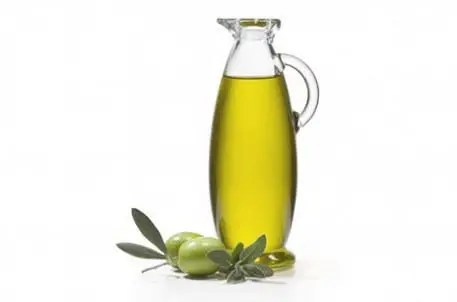

Like all fats, olive oil is a fairly high-calorie product (one tablespoon contains about 120 kcal). This should be taken into account by those who are on a diet.
Olive oil has a pronounced choleretic effect. Therefore, people with cholecystitis, as well as in the presence of stones in the gallbladder, should use it with caution and not on an empty stomach.
Excess consumption of olive oil can cause lower blood pressure, obesity, and an increased risk of diabetes. Therefore, do not consume more than 2 tbsp. tablespoons of olive oil a day.
It is best not to use olive oil for frying. Under the influence of high temperatures, oil begins to “smoke”, and fats – to oxidize, as a result, instead of useful antioxidants, free radicals and other dangerous compounds are formed. It is best used as a dressing for salad and other cold dishes.
It is not recommended to be added to food for people suffering from cholecystitis, since it has a choleretic effect.
How to choose olive oil
Let’s start with the country of origin. Firstly, Greek, Spanish and Italian olive oils are radically different in taste from each other.
Greek olive oil is very bright and rich in taste, which is distinguished by the presence of honey notes and some fruity aromas. Spanish oil has a harsh aroma and a bitter, peppery taste. We can say that it resembles the taste of the olives themselves more than others.


To do this, the Spaniards often mix several varieties of olives at once. Italian olive oil is soft, slightly sweet in taste, with a subtle herbal scent. It is in Italy that oil is produced with the addition of various spices and spices – basil, oregano, chili, rosemary, garlic and other aromatic additives.
And yes, besides Greece, Spain and Italy, olive oil is also produced in Turkey, Israel, Syria, Tunisia, Morocco, Portugal, USA and France. All of them differ in taste, as it all depends on the variety of olives, as well as on the climate in which they grow.
Arguing which of the oils is better and tastier is a waste of time, it all depends on your taste preferences. But how to choose a good olive oil in the store, read our tips.
Advice 1. EXTRA VIRGIN lettering
This oil is considered the best as it comes without any additives or preservatives. It can be compared to freshly squeezed fruit juice, in fact, it is a kind of “fresh” from olives: the oil is obtained by pressing the olives exclusively by mechanical means, i.e. without the use of chemical and biochemical additives.
Advice 2. Determine what you need olive oil for
Extra virgin oil fortified with vitamins is ideal for dressing salads, but not suitable for frying and other types of thermal processing. Useful substances under the influence of high temperatures turn into almost poison.
If you buy olive oil to fry in it or add it when baking, then opt for refined olive oil, also known as Pure.
Advice 3. Packaging
Proper packaging is very important. Ideally, olive oil should be in a darkened glass bottle. Such measures are designed to protect the oil from the harmful effects of external factors. It is for the same reason that olive oil is recommended to be stored in a dark and slightly cool place. If the bottle is transparent, then the oil in it is, accordingly, not very good quality.
Advice 4. Acidity
Another important parameter to consider in order to buy good olive oil is its acidity level. It is determined by the content of oleic acid in the oil. Your task is to buy olive oil with the lowest possible acidity.
Advice 5. Colour
As we said before, quality oil is sold in tinted glass bottles, through which the real color of the oil cannot be seen. Therefore, you can only check the color at home. But still pay attention to this fact when you open the stopper in the kitchen.
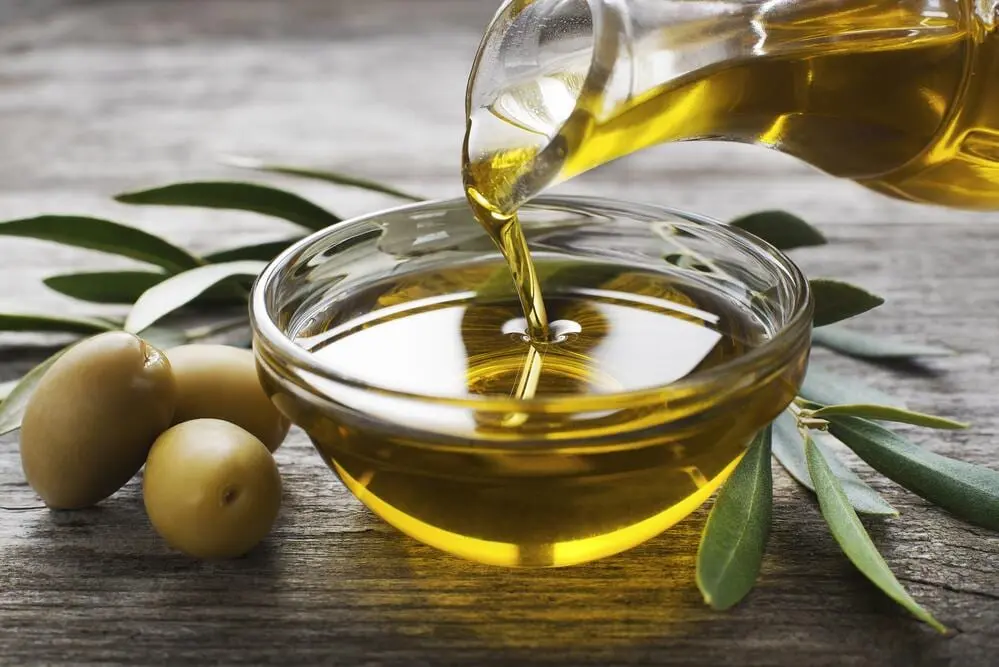

Quality olive oil has a pleasant golden color. The gray or deep green color of the oil indicates that it was made from overripe olives.
Advice 6. Manufacturing date
Olive oil is not wine. Over time, it does not gain useful properties, but only loses in quality. Therefore, be sure to pay attention to the date of manufacture. On average, it should take approximately 18 months from the date of manufacture to the expiration date.
This is the period of time when olive oil remains healthy and of high quality. Try to choose the freshest olive oil that has been produced recently.
Advice 7. Taste
Olive oil flavor always plays a decisive role. Wateriness, rancidity, vinegar or metallic taste are considered obvious deviations. Good oil can be sweetish, slightly bitter or sour – it all depends on the type of olives and the country of origin.
But! Even if you choose butter according to the rules, there is no guarantee that you will like its taste. As we already said, oils from different countries are radically different from each other. Perhaps you will not “go” with oil from Greece, but you will fall in love with Spanish or Turkish from the first drop. Therefore – taste it.
Olive oil classification
Depending on the quality indicators, identified on the basis of the physicochemical and organoleptic properties of the oil, the European legislation divides olive oil into different categories.
On the shelves of any store, you can see four main categories of olive oil, suitable for consumption:
- Extra virgin olive oil, or in Spanish “Aceite de Oliva Extra Virgen”.
- Unrefined olive oil (Virgin olive oil) or in Spanish “Aceite de Oliva Virgen”.
- Refined olive oil with the addition of unrefined olive oils (Olive oil) in Spanish “Aceite de Oliva”.
- Refined olive oil from pomace with the addition of unrefined olive oil (Olive-pomace oil) Extra virgin olive oil, Romas or in Spanish “Aceite de orujo de oliva”.
The best and healthiest olive oil is extra virgin olive oil of the highest quality.
Interesting Facts
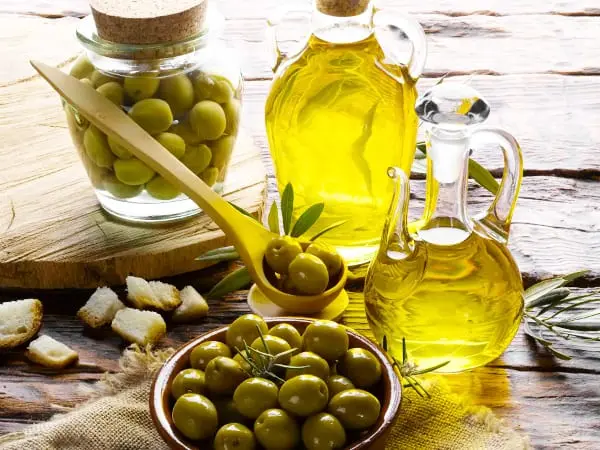

Several Mediterranean countries such as Greece, Spain and France have museums dedicated to the history of olive oil.
In Madrid, there is the International Olive Council, which controls the production of 95% of the world’s olive oil production. This intergovernmental organization makes one of its tasks the popularization of oil all over the world. It was created under the auspices of the UN in 1959.
Olive oil is one of the most popular food products in the world and is subject to frequent counterfeiting. In 1981, oil, diluted with industrial rapeseed, went on sale, the use of which led to the death of about 700 Spaniards. According to some estimates, about 40 percent of the olive oil on the world market today is counterfeit.
Olive oil production
To obtain oil, the olive fruits are crushed, then the mass is stirred and then the oil is squeezed out. For this, presses of various designs are used, most often centrifuges. It is worth noting that the extra virgin olive pomace is also used to produce olive oil, which is considered to be of the worst quality.
The most valuable is the oil, which, upon receipt, did not heat up to a temperature above 27 degrees. This oil is indicated by the word “cold” on the label.
The use of olive oil in medicine
Cardiovascular diseases are one of the most common among all diseases: they often cause death. Olive oil helps reduce the risk of stroke due to the presence of monounsaturated fats. Scientists have concluded that olive oil is the only source of this type of fat that can influence the course of diseases and protect against stroke. Moreover, more than 800 thousand people took part in the studies, they lasted for a dozen years.
Regular intake of olive oil in food reduces the risk of developing type 2 diabetes. The fact is that the substances in the composition affect insulin sensitivity and blood sugar levels. It is important to note that in this study, olive oil was added to meals and study participants followed a Mediterranean diet.
Malignant tumors are among the main causes of death in the world. Among the inhabitants of the Mediterranean countries, cases of oncological diseases are recorded less frequently than in other regions. Scientists attribute this phenomenon to the high consumption of olive oil in the daily diet. The antioxidant compounds in olive oil protect cells from oxidative stress caused by free radicals. A number of scientists believe that oxidative damage is the main cause of malignant cell transformations. Laboratory experiments have proven that the biochemical substances of olive oil inhibit the growth and development of cancer cells.
In addition, olive oil has anti-inflammatory properties: oleocanthal in the composition is also called an analogue of ibuprofen.
The use of olive oil in cooking
Olive oil is widely used in cooking: as a base for sauces, as an addition to side dishes, as a salad dressing, as an ingredient for second and main courses. Baking thanks to olive oil becomes softer and more magnificent: just a couple of drops are enough. Often they are replaced by other oils, such as sunflower. Olive oil has a more pronounced aroma and taste, while it can both soften the dish and give it a piquant, unique taste.
Popular questions and answers
Gastroenterologist Tatyana Pozdeeva answered popular questions.
Can you fry food in olive oil?
Yes, but you should use refined olive oil for this. It has more fatty acids: this makes the smoke point much higher.
How much olive oil can be consumed per day?
If you want to maintain energy and general tone, you can take up to 30 ml of olive oil during the day. For medicinal purposes, it is recommended to drink up to 15 ml of oil per day. The best time to take it is in the morning, before breakfast. Eating on an empty stomach promotes rapid and complete absorption. After taking olive oil, it is not recommended to drink water, any drinks, eat food for 20-30 minutes.
Who should stop taking olive oil in food?
Allergy to olive oil is quite rare. Some people find it difficult to take the product on an empty stomach. There are contraindications in which you should refrain from taking olive oil in large doses. These are hypersensitivity to the active substances of the olive, gallbladder disease, acute pancreatitis and exacerbation of stomach ulcers.











Hoe zit het met de biologische kwaliteit.
In Griekenland mogen geen chemische stoffen gebruikt worden….waarom worden olyven groen ,onryp geplukt en dan behandelt om ze zwart of ryp te maken ?